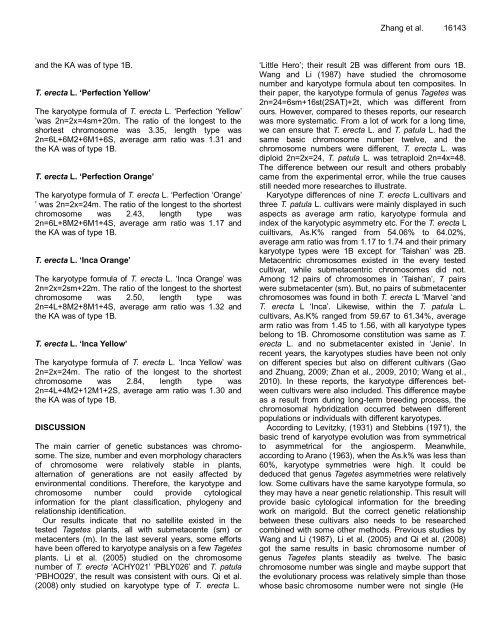(L.) C. Jeffrey from India using internal transcribed - Academic ...
(L.) C. Jeffrey from India using internal transcribed - Academic ...
(L.) C. Jeffrey from India using internal transcribed - Academic ...
You also want an ePaper? Increase the reach of your titles
YUMPU automatically turns print PDFs into web optimized ePapers that Google loves.
and the KA was of type 1B.<br />
T. erecta L. ‘Perfection Yellow’<br />
The karyotype formula of T. erecta L. ‘Perfection ‘Yellow’<br />
’was 2n=2x=4sm+20m. The ratio of the longest to the<br />
shortest chromosome was 3.35, length type was<br />
2n=6L+6M2+6M1+6S, average arm ratio was 1.31 and<br />
the KA was of type 1B.<br />
T. erecta L. ‘Perfection Orange’<br />
The karyotype formula of T. erecta L. ‘Perfection ‘Orange’<br />
’ was 2n=2x=24m. The ratio of the longest to the shortest<br />
chromosome was 2.43, length type was<br />
2n=6L+8M2+6M1+4S, average arm ratio was 1.17 and<br />
the KA was of type 1B.<br />
T. erecta L. ‘Inca Orange’<br />
The karyotype formula of T. erecta L. ‘Inca Orange’ was<br />
2n=2x=2sm+22m. The ratio of the longest to the shortest<br />
chromosome was 2.50, length type was<br />
2n=4L+8M2+8M1+4S, average arm ratio was 1.32 and<br />
the KA was of type 1B.<br />
T. erecta L. ‘Inca Yellow’<br />
The karyotype formula of T. erecta L. ‘Inca Yellow’ was<br />
2n=2x=24m. The ratio of the longest to the shortest<br />
chromosome was 2.84, length type was<br />
2n=4L+4M2+12M1+2S, average arm ratio was 1.30 and<br />
the KA was of type 1B.<br />
DISCUSSION<br />
The main carrier of genetic substances was chromosome.<br />
The size, number and even morphology characters<br />
of chromosome were relatively stable in plants,<br />
alternation of generations are not easily affected by<br />
environmental conditions. Therefore, the karyotype and<br />
chromosome number could provide cytological<br />
information for the plant classification, phylogeny and<br />
relationship identification.<br />
Our results indicate that no satellite existed in the<br />
tested Tagetes plants, all with submetacente (sm) or<br />
metacenters (m). In the last several years, some efforts<br />
have been offered to karyotype analysis on a few Tagetes<br />
plants. Li et al. (2005) studied on the chromosome<br />
number of T. erecta ‘ACHY021’ ‘PBLY026’ and T. patula<br />
‘PBHO029’, the result was consistent with ours. Qi et al.<br />
(2008) only studied on karyotype type of T. erecta L.<br />
Zhang et al. 16143<br />
‘Little Hero’; their result 2B was different <strong>from</strong> ours 1B.<br />
Wang and Li (1987) have studied the chromosome<br />
number and karyotype formula about ten composites. In<br />
their paper, the karyotype formula of genus Tagetes was<br />
2n=24=6sm+16st(2SAT)+2t, which was different <strong>from</strong><br />
ours. However, compared to theses reports, our research<br />
was more systematic. From a lot of work for a long time,<br />
we can ensure that T. erecta L. and T. patula L. had the<br />
same basic chromosome number twelve, and the<br />
chromosome numbers were different, T. erecta L. was<br />
diploid 2n=2x=24, T. patula L. was tetraploid 2n=4x=48.<br />
The difference between our result and others probably<br />
came <strong>from</strong> the experimental error, while the true causes<br />
still needed more researches to illustrate.<br />
Karyotype differences of nine T. erecta L.cultivars and<br />
three T. patula L. cultivars were mainly displayed in such<br />
aspects as average arm ratio, karyotype formula and<br />
index of the karyotypic asymmetry etc. For the T. erecta L<br />
cuiltivars, As.K% ranged <strong>from</strong> 54.06% to 64.02%,<br />
average arm ratio was <strong>from</strong> 1.17 to 1.74 and their primary<br />
karyotype types were 1B except for ‘Taishan’ was 2B.<br />
Metacentric chromosomes existed in the every tested<br />
cultivar, while submetacentric chromosomes did not.<br />
Among 12 pairs of chromosomes in ‘Taishan’, 7 pairs<br />
were submetacenter (sm). But, no pairs of submetacenter<br />
chromosomes was found in both T. erecta L ‘Marvel ‘and<br />
T. erecta L ‘Inca’. Likewise, within the T. patula L.<br />
cultivars, As.K% ranged <strong>from</strong> 59.67 to 61.34%, average<br />
arm ratio was <strong>from</strong> 1.45 to 1.56, with all karyotype types<br />
belong to 1B. Chromosome constitution was same as T.<br />
erecta L. and no submetacenter existed in ‘Jenie’. In<br />
recent years, the karyotypes studies have been not only<br />
on different species but also on different cultivars (Gao<br />
and Zhuang, 2009; Zhan et al., 2009, 2010; Wang et al.,<br />
2010). In these reports, the karyotype differences between<br />
cultivars were also included. This difference maybe<br />
as a result <strong>from</strong> during long-term breeding process, the<br />
chromosomal hybridization occurred between different<br />
populations or individuals with different karyotypes.<br />
According to Levitzky, (1931) and Stebbins (1971), the<br />
basic trend of karyotype evolution was <strong>from</strong> symmetrical<br />
to asymmetrical for the angiosperm. Meanwhile,<br />
according to Arano (1963), when the As.k% was less than<br />
60%, karyotype symmetries were high. It could be<br />
deduced that genus Tagetes asymmetries were relatively<br />
low. Some cultivars have the same karyotype formula, so<br />
they may have a near genetic relationship. This result will<br />
provide basic cytological information for the breeding<br />
work on marigold. But the correct genetic relationship<br />
between these cultivars also needs to be researched<br />
combined with some other methods. Previous studies by<br />
Wang and Li (1987), Li et al. (2005) and Qi et al. (2008)<br />
got the same results in basic chromosome number of<br />
genus Tagetes plants steadily as twelve. The basic<br />
chromosome number was single and maybe support that<br />
the evolutionary process was relatively simple than those<br />
whose basic chromosome number were not single (He

















